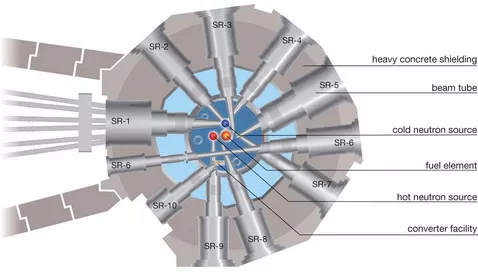Guiding the beams
Neutrons are electrically neutral components of atomic nuclei, have a diameter of ca. 1.7 × 10-15 m and usually penetrate matter easily. Therefore they can only be "guided" in a very limited way. Initially, they fly in all directions with a mean velocity determined by the temperature of the moderator and one could use in experiments only those neutrons that would by chance be flying in the right direction. In this case, only very few would arrive at the experiment, because their number would decrease with the square of the distance (i.e. at 2 m distance from the fuel element, 4 times fewer neutrons would be available than at 1 m distance).
Neutron guides bundle neutrons
But neutrons are also matter waves, that is, they obey the laws of optics, as we know them from visible light. Neutron guide through bundled reflection allows the forwarding of a wide wavelength band of neutrons. The diffraction of neutrons on single crystals permits, as in a prism at certain angles, the separation of certain colours, ie the monochromization of the neutron guide light. Compared to the optics with visible light it is to be noted, however, that the refractive difference between vacuum and matter is smaller for the neutron light by many orders of magnitude, ie, all optical components for the guidance of the neutron light are very large.
Eleven beam tubes provide neutrons for experiments
These neutron guides or single crystals for monochromatisation cannot be placed directly in the moderator due to anticipated irradiation damage. Typically, the first optical guiding components start 2-5 metres beyond the fuel element, still in the beam tube channels. In total, the FRM II has 10 horizontal and one inclined beam tube, which regularly provide neutrons for numerous experiments.
